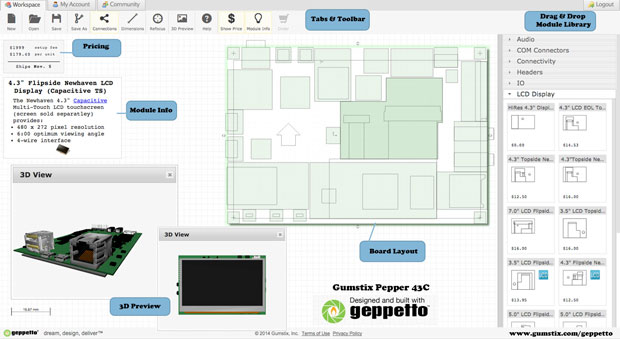
Geppetto includes a 100-module library and a visual design process. Image courtesy of Gumstix.
Latest News
October 20, 2015
By Andrew Simpson, Gumstix
In a long line of electronic design automation (EDA) advancements, design-to-order (D2O) tools stand as one of the newest innovations. Developers can build custom boards quickly and easily, using an intuitive Web-based interface. Yet while this process fuels a new approach to embedded development, it may be D2O’s supply chain features that add the most value to the industry landscape. The platform offers OEMs (original equipment manufacturers) clear insight on how specific modules influence costs – and once the design is complete, product sourcing and manufacturing are streamlined with supply chain resources that are seamlessly integrated behind the platform.
The Value of D2O
D2O creates a drag-and-drop, modular design environment, where developers can readily access ‘blocks’ or modules of functionality. An array of tools lets designers click to implement functions such as connectivity or networking, or features such as USB hubs and ports. Platforms offer simple toggle control of information and options, and a clear signal when the design is complete and ready for 3D rendering and viewing. Once designed and ordered online, boards are verified for proper routing. Everything such as PCB (printed circuit board) printing, component sourcing and the fabrication of the finished product is handled by the D2O system.
 With Gumstix’ Geppetto design-to-order (D2O) tool, users have access to the entire process of design, supply chain integration and manufacturing automation with one online resource. Image courtesy of Gumstix.
With Gumstix’ Geppetto design-to-order (D2O) tool, users have access to the entire process of design, supply chain integration and manufacturing automation with one online resource. Image courtesy of Gumstix.In contrast to the established two to three months development time, D2O enables development from design concept to production-ready boards available in about three weeks. Total cost of ownership includes only a setup and manufacturing fee of less than $2K plus component costs, a remarkable comparison to the $20K-$50K investment that accompanies conventional EDA applications. These values are why and how D2O is disrupting the market – making EDA accessible to OEMs large and small, as well as hobbyists and makers of sophisticated customized electronic designs.
Connecting D2O and the Supply Chain
Geppetto, an optimized D2O platform, includes an approximately 100-module library. To illustrate the D2O process, designers can easily add features such as Wi-Fi, audio, LCDs, sensors, global navigation (GPS) chips or USB connectivity to their embedded board. Overall, the D2O tool abstracts hardware design to a higher level than basic componentry, speeding development and removing risk.
Because the costly steps of schematic, layout, BOM, fabs, assembly and testing, between design and production are eliminated from the mix, D2O is optimized for OEMs at all levels. Large-scale development of thousands of boards, or individual or one-off projects that are used for quick prototyping – it makes no difference in the realm of D2O. Creating a custom device is quick and cost-effective, and the process allows developers to focus on how to distinguish their software instead of board layouts. Users can also choose to design a board from the ground up or modify an existing board for required application performance.
D2O is making a difference by considering design costs along with engineering cost and supply-chain logistics. It’s adding a new dynamic to EDA, accelerating online design options and enabling designers to easily develop a product from definition to first boot-up. Simplified design, rapid time to market and affordability are at the heart of D2O – these factors remove design barriers and are driving the next significant shift in EDA evolution.
More Info
Subscribe to our FREE magazine, FREE email newsletters or both!
Latest News







